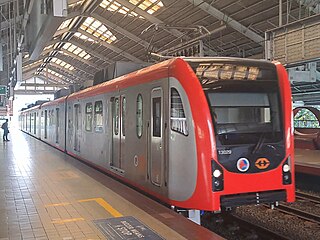
The Manila Light Rail Transit System, commonly known as the LRT, is an urban rail transit system that primarily serves Metro Manila, Philippines. Although categorized as a light rail system because it originally used light rail vehicles, it presently has characteristics of a rapid transit system, such as high passenger throughput, exclusive right-of-way, and later use of full metro rolling stock. The LRT is jointly-operated by the Light Rail Transit Authority (LRTA), a government corporation attached to the Department of Transportation (DOTr), and the Light Rail Manila Corporation (LRMC). Along with the Manila Metro Rail Transit System and the Metro Commuter Line of the Philippine National Railways, the system makes up Metro Manila's rail infrastructure.

The Metro Rail Transit Line 3, also known as the MRT Line 3, MRT-3 or Metrostar Express, is a rapid transit line in Metro Manila in the Philippines. The line runs in an orbital north to south route following the alignment of Epifanio de los Santos Avenue (EDSA). Despite its name, the line is more akin to a light rapid transit system owing to its tram-like rolling stock while having total grade separation and high passenger throughput. The line is officially known as the Yellow Line.
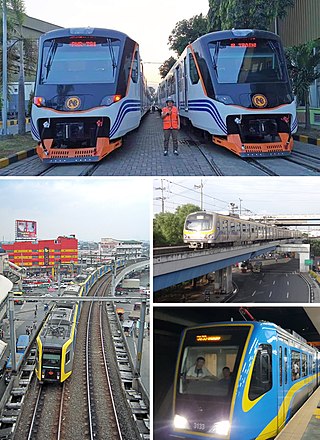
Rail transportation in the Philippines is currently used mostly to transport passengers within Metro Manila and provinces of Laguna and Quezon, as well as a commuter service in the Bicol Region. Freight transport services once operated in the country, but these services were halted. However, there are plans to restore old freight services and build new lines. From a peak of 1,100 kilometers (680 mi), the country currently has a railway footprint of 533.14 kilometers (331.28 mi), of which only 129.85 kilometers (80.69 mi) are operational as of 2024, including all the urban rail lines. World War II, natural calamities, underspending, and neglect have all contributed to the decline of the Philippine railway network. In the 2019 Global Competitiveness Report, the Philippines has the lowest efficiency score among other Asian countries in terms of efficiency of train services, receiving a score of 2.4, and ranking 86th out of 101 countries globally. The government is currently expanding the railway network up to 1,900 kilometers (1,200 mi) by 2022 through numerous projects.

The Light Rail Transit Authority (LRTA) is a public transport operator that is responsible for the construction, operation, maintenance and/or lease of Manila Light Rail Transit System in the Philippines. It is organized as a government-owned and controlled corporation under the Department of Transportation (DOTr) as an attached agency.

The Light Rail Transit Line 1, commonly referred to as LRT Line 1 or LRT-1, is a light rapid transit system line in Metro Manila, Philippines, operated by Light Rail Manila Corporation (LRMC) and owned by the Light Rail Transit Authority (LRTA) as part of the Manila Light Rail Transit System. Originally referred to as Metrorail and the Yellow Line, LRT Line 1 was reclassified to be the Green Line in 2012. It travels in a general north–south direction from Baclaran to Monumento, and then east–west from Monumento to Fernando Poe Jr. Currently, the line consists of 20 stations and runs on 19.65 kilometers of fully elevated route. Although it has the characteristics of light rail, such as with the type of rolling stock used, it is more akin to a rapid transit system owing to its total grade separation and high passenger throughput.

The Light Rail Transit Line 2, also known as LRT Line 2,LRT-2, or Megatren, is a rapid transit line in Metro Manila in the Philippines owned and operated by the Light Rail Transit Authority (LRTA). The line generally runs in an east–west direction between Recto in Manila and Antipolo. The line is officially referred to as the Purple Line.

MIA station, also known as Manila International Airport station, is an under-construction Light Rail Transit (LRT) station located on the LRT Line 1 (LRT-1) system in Parañaque. It is a part of the LRT-1 South Extension Project.
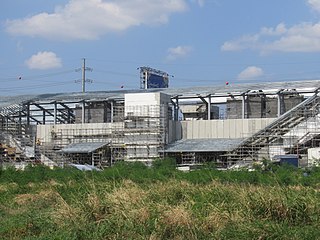
Redemptorist station is an under-construction Light Rail Transit (LRT) station located on the LRT Line 1 (LRT-1) system in Parañaque. It is part of the Line 1 South Extension Project. The station would be the northernmost of the extension. It would be the twenty-second station from the northern terminus at Common Station. It would be built in Aseana City in Barangay Baclaran and would be named after the nearby Redemptorist Road.

Zapote station is an under-construction Light Rail Transit (LRT) station located on the LRT Line 1 (LRT-1) system in Bacoor, Cavite. Zapote differs from other LRT-1 stations in that it will be constructed at grade. It is part of the LRT-1 South Extension Project. The station would be the first LRT-1 station outside Metro Manila. The station will be situated near the Zapote Exit Ramp of Manila-Cavite Expressway in Barangay Zapote V (Longos).

The Metro Rail Transit Corporation (MRTC), is a private consortium organized in June 1995. The consortium is composed of seven (7) Filipino-owned companies: Fil-Estate Management Inc, Ayala Land Inc, Ramcar Inc, Greenfield Development Corporation of Unilab, Anglo-Philippine Holdings Corporation, National Book Store Group, Allante Realty and Development Inc, and DBH Inc. The Metro Rail Transit Corporation owns the Manila Metro Rail Transit System Line 3 running along the EDSA corridor. MRTC was the original contractor for the EDSA MRT-3 Project. It runs the MRT-3 in coordination with the Department of Transportation under a 25-year Build-Lease-Transfer contract or BLT Agreement, which will end in 2025.

Asia World station is an under-construction Light Rail Transit (LRT) station located on the LRT Line 1 (LRT-1) system in Parañaque. Named after the nearby Asiaworld district where it is situated, it is part of the LRT-1 South Extension Project to Cavite.

Metro Pacific Investments Corporation (MPIC) is a Philippine-based unit investment holding company of First Pacific Company Limited through Metro Pacific Holdings, Inc. MPIC through its subsidiaries, provides water, sanitation, and sewerage services and also operates in real estate, and infrastructure projects. It also invests in some hospitals in the Philippines.
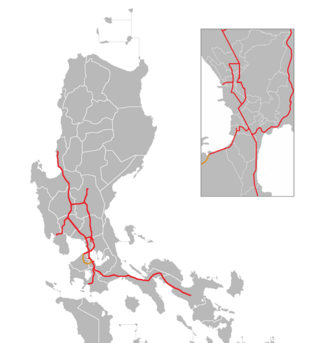
The Cavite–Laguna Expressway, signed as E3 of the Philippine expressway network, is a partially operational controlled-access toll expressway in the provinces of Cavite and Laguna, Philippines. The construction of the 44.63-kilometer-long (27.73 mi) expressway, which began in June 2017, costs an estimated ₱35.43 billion. Once completed, it will connect the Manila–Cavite Expressway in Kawit to the South Luzon Expressway in Biñan and is expected to ease the traffic congestion in the Cavite–Laguna area, particularly along the Aguinaldo Highway, Governor's Drive, and the Santa Rosa–Tagaytay Road.
The Light Rail Transit Line 6 is a proposed rapid transit system in Cavite, Philippines. There have been two proposals for the line, with the first one shelved immediately in 2018. Another proposal emerged in 2017 and is currently under review by the National Economic and Development Authority (NEDA).
The Metro Manila Subway, formerly known as the Mega Manila Subway (MMS), is an under-construction underground rapid transit line in Metro Manila, Philippines. The 33-kilometer (21 mi) line, which will run north–south between Valenzuela, Quezon City, Pasig, Taguig, Parañaque and Pasay, consists of 17 stations between the East Valenzuela and Bicutan stations. It will become the country's second direct airport rail link after the North–South Commuter Railway, with a branch line to Ninoy Aquino International Airport.

The LRTA 1000 class is the first-generation class of high-floor light rail vehicles (LRV) currently operated by the Light Rail Manila Corporation. It first entered service under the Light Rail Transit Authority in 1984 on the LRT Line 1.
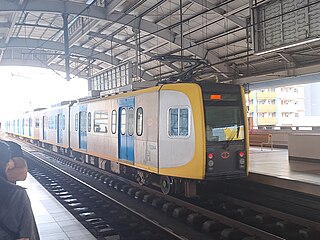
The LRTA 1200 class is the third-generation class of high-floor light rail vehicles (LRV) of the Light Rail Transit Authority servicing the Manila LRT Line 1. Purchased as part of the second phase of the capacity expansion of the line, the trains entered service in December 2006.

The LRTA 1100 class is the second-generation class of high-floor light rail vehicles of the Light Rail Transit Authority (LRTA) in Manila, Philippines, which began operation in 1999.

The LRTA 13000 class is a class of fourth-generation high-floor light rail vehicles (LRV) of the Light Rail Transit Authority servicing the Manila LRT Line 1. Purchased in 2017 as part of the south extension of the line, the trains entered service in July 2023 to replace the aging first-generation 1000 class trains.

Rail transportation in the Greater Manila Area is a major part of the transportation system in Metro Manila and its surrounding areas. It consists of the Manila Light Rail Transit System, Manila Metro Rail Transit System, and the PNR Metro Commuter Line. The network makes up the majority of active railways in the country and bear the brunt of providing the metropolis with rail as a faster alternative mode of transport other than buses and jeepneys. However, these systems are currently insufficient for the rapidly expanding metropolis; to address this, new lines and line extensions are under construction, which will extend the system far out into neighboring regions.


















